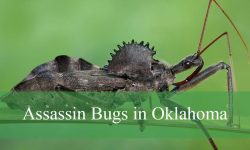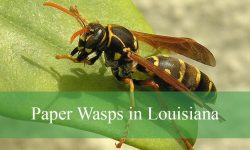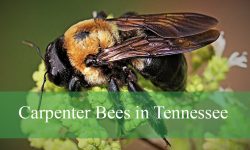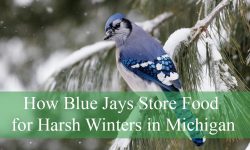New Hampshire’s diverse habitats are home to many small brown birds that can be challenging yet rewarding to identify. From sparrows and wrens to juncos and towhees, these modestly colored birds play vital roles in local ecosystems.
In this guide, you’ll discover detailed descriptions, behaviors, and habitats of 26 common small brown bird species found across the state, complete with helpful pictures to aid birdwatching enthusiasts and beginners alike.
Common Small Brown Birds Found in New Hampshire
Song Sparrow (Melospiza melodia)
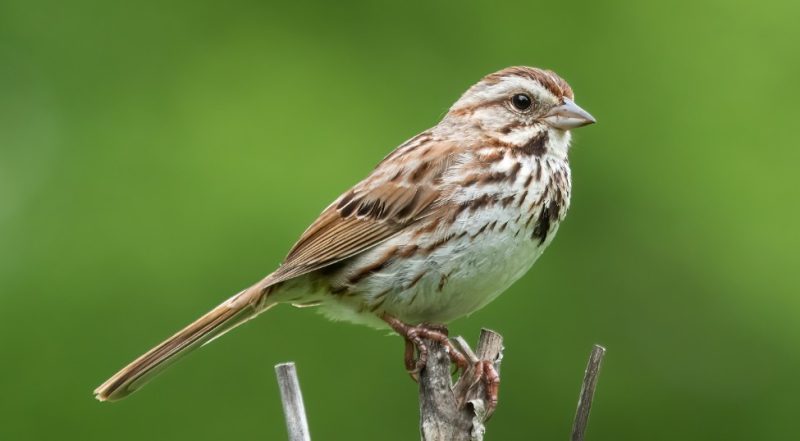
The Song Sparrow is one of the most widespread and easily recognized small brown birds in New Hampshire. It has a streaked brown and gray body with a distinctive dark spot in the center of its chest, making it easier to identify compared to other “little brown jobs.” This medium-sized sparrow measures around 5.9–6.7 inches (15–17 cm) in length and has a long, rounded tail often flicked nervously. Its stout bill is perfect for cracking seeds, which make up a large portion of its diet.
In New Hampshire, Song Sparrows are found year-round, thriving in open habitats such as meadows, brushy fields, woodland edges, and even suburban gardens. They are frequent visitors to backyard feeders, especially if sunflower or millet seeds are available. During the breeding season, males perch in open areas, delivering their melodious and cheerful song, which helps establish territories and attract mates.
Behaviorally, Song Sparrows are ground foragers, scratching at leaf litter for insects, seeds, and small fruits. They are adaptable and tolerate human presence, often seen hopping around near homes or along walking trails. Their nests are typically well-hidden in shrubs or tall grass, providing camouflage from predators.
Fun Fact: Song Sparrows have regional “dialects,” meaning males from different parts of New Hampshire may sing slightly different versions of the same song. This unique variation is a fascinating example of how bird populations develop local adaptations over time.
Swamp Sparrow (Melospiza georgiana)
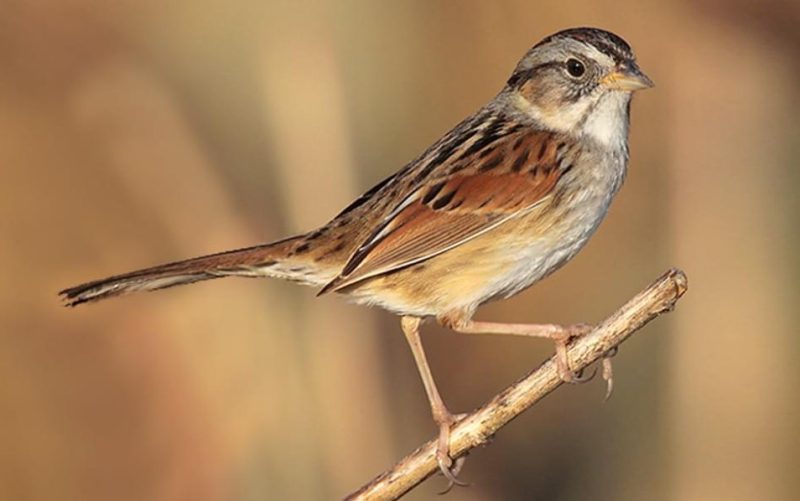
The Swamp Sparrow is a secretive, warm-toned brown sparrow that thrives in wet habitats. Its plumage is a rich chestnut brown on the wings and back, with a grayish face and nape, giving it a slightly more refined look than its close relative, the Song Sparrow. Adults measure around 4.7–5.5 inches (12–14 cm) and have long legs adapted for walking through dense marsh vegetation. The short, conical bill is perfect for eating seeds and small invertebrates.
This species is more elusive than many other sparrows in New Hampshire, preferring cattail marshes, bogs, and wet meadows. While they breed in the northern parts of the state, they can also be seen during migration in other wetland areas. Their song is a slow, sweet trill, less complex than that of the Song Sparrow but pleasant and distinctive to trained ears.
Swamp Sparrows are primarily ground-dwellers, moving quietly through dense vegetation, often going unnoticed unless singing. Their diet shifts seasonally, with insects being a primary food source in the summer and seeds making up most of their winter diet. Because of their preference for wet environments, they rarely visit backyard feeders.
Fun Fact: Swamp Sparrows have slightly longer legs than many other sparrows, allowing them to wade into shallow water to forage—something few sparrows regularly do.
American Tree Sparrow (Spizelloides arborea)
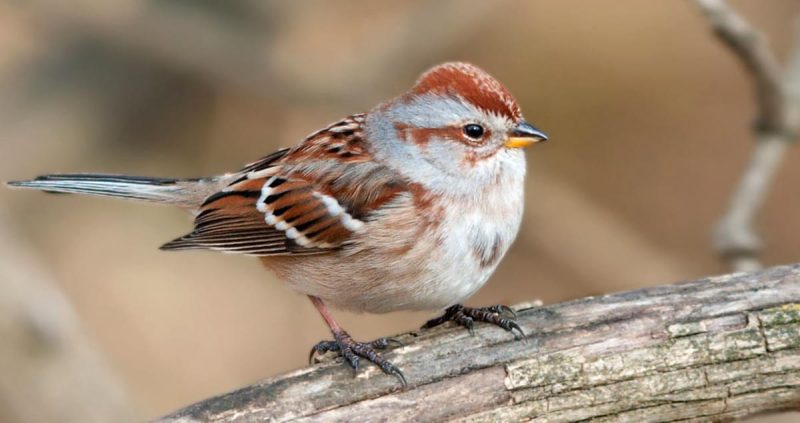
The American Tree Sparrow is a winter visitor in New Hampshire, arriving from its Arctic breeding grounds to escape harsh northern winters. Despite its name, it spends much of its time on the ground rather than in trees. It is a handsome sparrow with a rusty cap, a grayish breast with a single dark central spot, and two white wing bars. Adults measure about 5.5–6.3 inches (14–16 cm) in length and have a bicolored bill—yellow below and dark above.
This sparrow favors open fields, weedy edges, and shrubby areas during the winter months. Flocks often visit backyard feeders, especially where millet, sunflower chips, or cracked corn are provided. They frequently scratch at the ground in search of fallen seeds, sometimes mixing with juncos or other sparrow species.
In terms of behavior, American Tree Sparrows are relatively tame and often feed in groups. Their soft musical trill can occasionally be heard even in the coldest winter months, adding a cheerful note to snowy landscapes. Their breeding grounds are in tundra regions, so they are perfectly adapted to cold weather and are comfortable in New Hampshire’s snowy winters.
Fun Fact: American Tree Sparrows are sometimes nicknamed “Winter Sparrows” in New England because they are almost exclusively seen in the region during the cold season.
House Sparrow – Female (Passer domesticus)
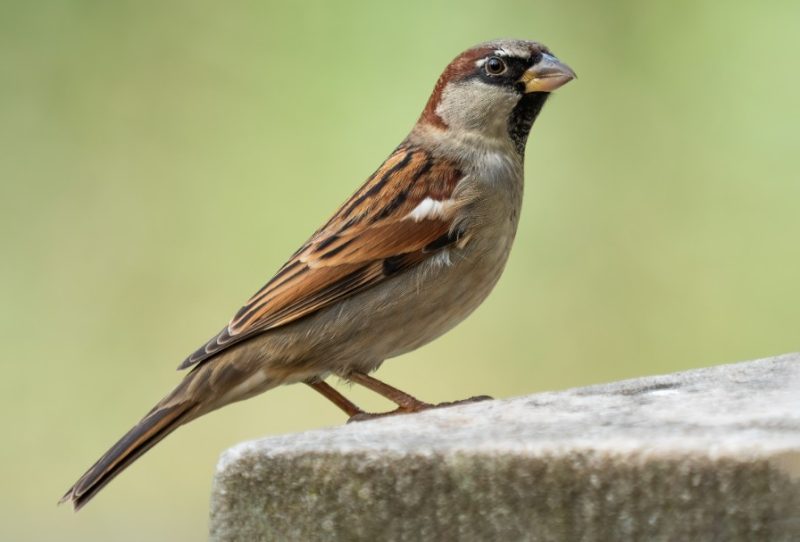
The female House Sparrow is a common sight around human settlements in New Hampshire. Unlike the more colorful males, females have a uniform dull brown and gray plumage, with pale eyebrows and streaked backs. They are stocky, measuring about 5.9–6.7 inches (15–17 cm) long, with a stout bill perfectly suited for cracking seeds and grains. Their simple coloration helps them blend into urban and rural settings.
House Sparrows are non-native to North America, introduced in the 1800s, and have since become widespread. They are year-round residents in New Hampshire, found in cities, towns, farms, and anywhere humans provide food or shelter. They nest in cavities, often in crevices of buildings, eaves, or even old woodpecker holes. Female House Sparrows are excellent mothers, sometimes raising multiple broods in a single season.
Behaviorally, they are highly social and often gather in noisy flocks around bird feeders, parking lots, or barns. Their diet consists mainly of grains and seeds, but they opportunistically eat insects, especially during nesting season when chicks require protein-rich food.
Fun Fact: Female House Sparrows often reuse the same nest site for many years, adding new layers of nesting material each season, resulting in bulky, long-standing nests.
Dark-eyed Junco (Junco hyemalis)
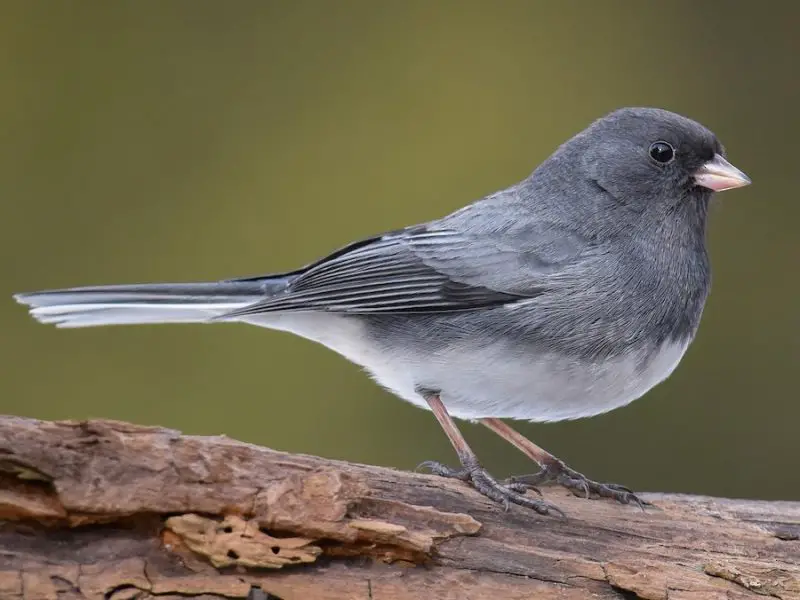
The Dark-eyed Junco is a charming small bird that winters in large numbers across New Hampshire. While many juncos have slate-gray plumage, some show more brownish tones, especially the females and immature birds. They are about 5.5–6.3 inches (14–16 cm) in length, with a round head, short stout bill, and a distinct white belly. When flying, they flash white outer tail feathers, making them easy to spot.
In New Hampshire, Dark-eyed Juncos are primarily winter visitors, frequenting backyards, forest edges, and weedy fields. They often travel in small flocks, foraging on the ground beneath feeders or scratching through leaf litter for seeds and insects. They are less commonly seen in summer, as they move north or to higher elevations for breeding.
Their behavior is active and sociable, with birds constantly hopping and flicking their tails. They are also known for a soft, twittering call and a high-pitched trill during the breeding season. Backyard birders often attract them with millet, cracked corn, or sunflower seeds scattered on the ground.
Fun Fact: Dark-eyed Juncos are nicknamed “snowbirds” because their arrival often coincides with the first snowfall of the season in New England.
White-throated Sparrow (Zonotrichia albicollis)
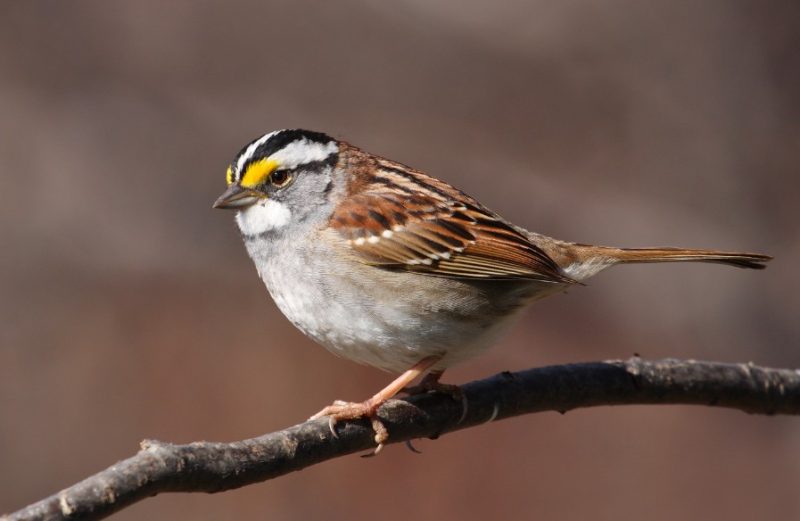
The White-throated Sparrow is a striking sparrow with brown streaked wings and back, a bright white throat patch, and yellow lores (spots between the eye and beak). It measures about 6.3–7.1 inches (16–18 cm) long and has two distinct color forms: white-striped and tan-striped. Both are common in New Hampshire, especially during migration and winter.
These sparrows prefer forest edges, thickets, and overgrown fields. In New Hampshire, many spend the winter scratching for seeds under shrubs or visiting ground feeders. Some remain year-round in southern parts of the state, while others migrate farther north to breed in summer. Their distinctive song sounds like “Oh-sweet-Canada-Canada,” which can be heard during spring and early summer.
White-throated Sparrows are ground foragers, often hopping and scratching through leaves to find seeds and insects. They are shy but will occasionally feed near humans if dense cover is nearby. Pairs form loose flocks in winter, which helps them stay safe from predators.
Fun Fact: White-throated Sparrows are known for having two genetic morphs (white-striped and tan-striped), and they almost always mate with the opposite morph, maintaining genetic diversity.
Chipping Sparrow (Spizella passerina)
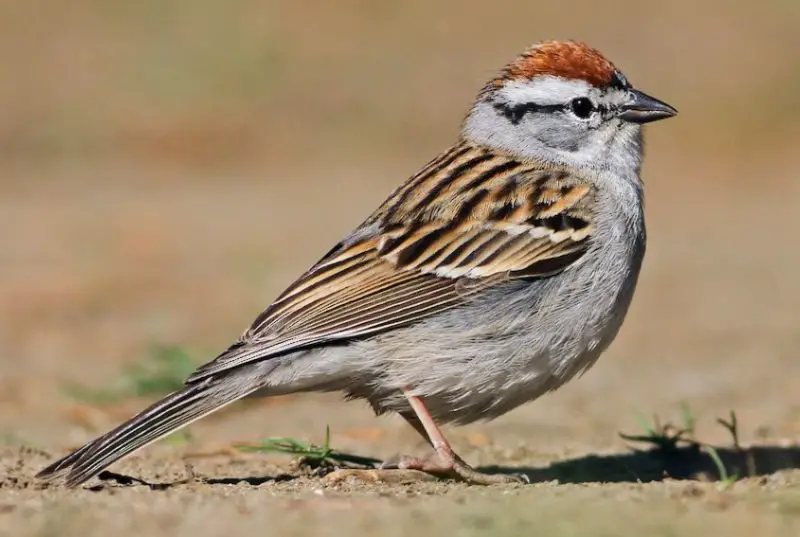
The Chipping Sparrow is a small, neat-looking sparrow with a bright rusty crown, a black eye line, and a clean grayish breast. It measures about 4.7–5.9 inches (12–15 cm) long and has a slim body compared to chunkier sparrows like Song Sparrows. Its delicate appearance makes it easy to identify once you know what to look for.
In New Hampshire, Chipping Sparrows are common in spring and summer, nesting in suburban gardens, forest edges, and open woodlands. They often forage on lawns and open fields, searching for grass seeds and insects. By late fall, most migrate south, leaving only a few stragglers in the state.
Their behavior is active and social, especially during breeding season when males sing a long, dry trill from exposed perches. They are frequent visitors to feeders, especially if millet or sunflower chips are provided. Their neat, cup-shaped nests are usually built in shrubs or low trees.
Fun Fact: Chipping Sparrows are one of the first sparrows to return to New Hampshire each spring, sometimes arriving before snow has fully melted.
Savannah Sparrow (Passerculus sandwichensis)
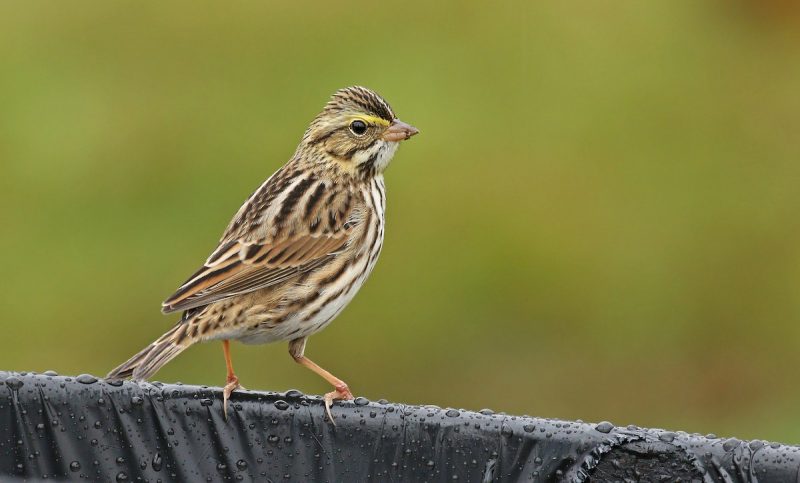
The Savannah Sparrow is a subtly marked sparrow with brown streaks, a short tail, and a distinctive yellowish tinge near the eye. It measures about 4.3–5.9 inches (11–15 cm) long and blends easily into grassy habitats. Its cryptic plumage helps protect it from predators while foraging on the ground.
In New Hampshire, Savannah Sparrows are common in summer, especially in open fields, coastal marshes, and hay meadows. They forage low to the ground, eating seeds and insects, and their presence is often detected by their soft, insect-like buzzing song. They migrate south in winter, leaving the state by late October.
Savannah Sparrows are ground nesters, building well-hidden nests in dense grass. They are cautious birds, usually staying low and flying only short distances when disturbed. Despite their secretive nature, they can be abundant in suitable habitats.
Fun Fact: The name “Savannah” doesn’t come from savannas; it comes from Savannah, Georgia, where the species was first described.
Field Sparrow (Spizella pusilla)
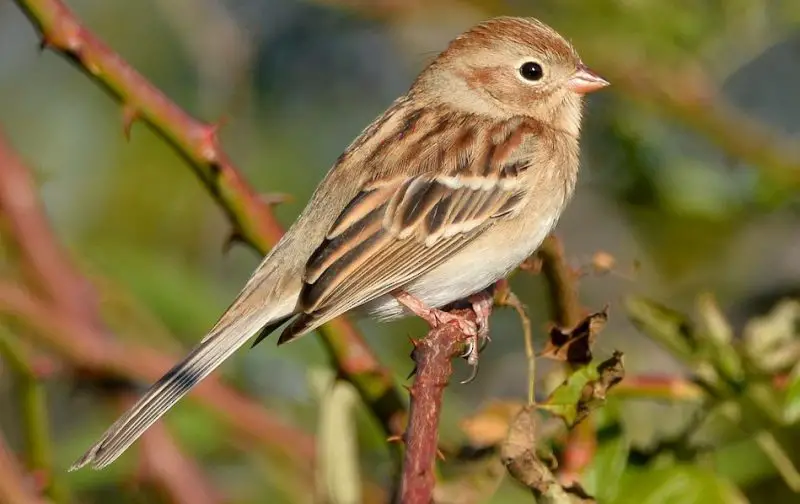
The Field Sparrow is a gentle-looking sparrow with a plain face, a rusty cap, a pink bill, and soft brown plumage. It is about 4.7–5.9 inches (12–15 cm) long and has a sweet, delicate expression that sets it apart from other sparrows. Its subtle coloration makes it well-suited to its grassy and shrubby habitats.
This species breeds in New Hampshire during the warmer months, favoring weedy fields, shrubby pastures, and regenerating clearings. It is less common near urban areas, preferring quiet, open country. Field Sparrows migrate south in winter, although a few may linger in the southern parts of the state.
Field Sparrows are shy, often staying low in grass or shrubs, emerging mostly to sing from exposed perches. Their song is a series of clear whistles that speed up, resembling a bouncing ball coming to rest. They forage primarily on seeds, switching to insects during breeding season.
Fun Fact: Unlike many sparrows that thrive near humans, Field Sparrows avoid developed areas, making them a symbol of wild, undisturbed fields in New Hampshire.
Grasshopper Sparrow (Ammodramus savannarum)
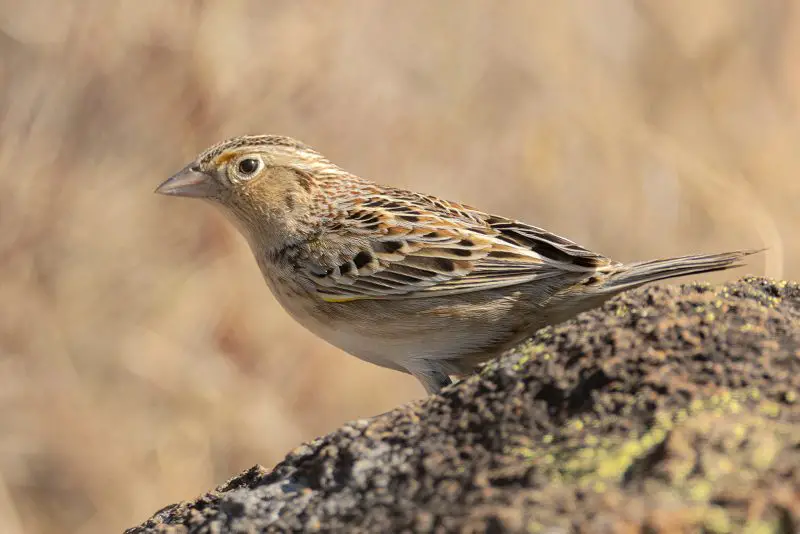
The Grasshopper Sparrow is a small, short-tailed sparrow with a flat-headed appearance and subtle streaking on its back. Its plumage is sandy brown with fine black markings, blending perfectly into grassy fields. Adults measure around 4.3–5.1 inches (11–13 cm) in length and have a pale, slightly pinkish bill. Its name comes from its insect-like song, which sounds like a faint grasshopper trill.
In New Hampshire, Grasshopper Sparrows are found primarily during the breeding season, favoring dry, open fields, hay meadows, and prairies. They are uncommon and localized, preferring habitats with sparse vegetation and little human disturbance. Their populations are declining in some areas due to habitat loss from modern farming and development.
Behaviorally, these sparrows are secretive, staying low in grass and rarely perching in the open except when singing. They forage on the ground for seeds and insects, relying heavily on grasshoppers and beetles during the summer. Their ground nests are well-hidden among clumps of grass, making them difficult to spot.
Fun Fact: Grasshopper Sparrows sometimes run through grass like tiny mice instead of flying, a behavior that helps them avoid predators.
Nelson’s Sparrow (Ammospiza nelsoni)
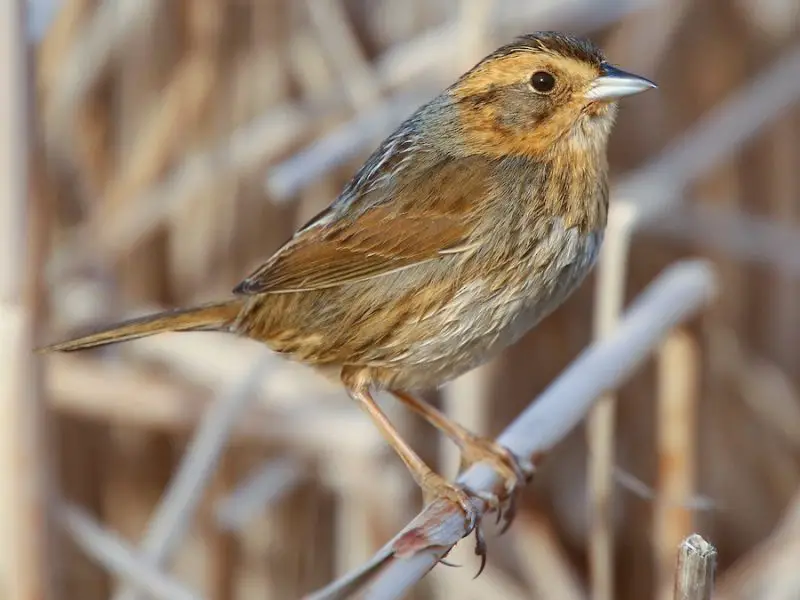
Nelson’s Sparrow is a shy, secretive bird with a warm buffy-orange face, gray cheeks, and fine brown streaking. It is about 4.3–5.1 inches (11–13 cm) long and has a short tail and compact body. Its soft, whispery song is barely audible unless you are close, making it one of the quieter sparrows.
In New Hampshire, Nelson’s Sparrows are mostly seen in coastal salt marshes and wet meadows during migration or occasionally in summer. They are not common inland and require specialized wet habitats, which makes spotting one a treat for birdwatchers.
Their behavior is elusive; they prefer to stay hidden in dense grasses and sedges, creeping through vegetation instead of flying. They feed on seeds, insects, and small crustaceans, which they find by probing in mud or among marsh plants. They are rarely seen at feeders due to their preference for wild, wet habitats.
Fun Fact: Nelson’s Sparrows build nests just above high-tide lines in marshes, sometimes risking flooding during unusually high tides.
Vesper Sparrow (Pooecetes gramineus)
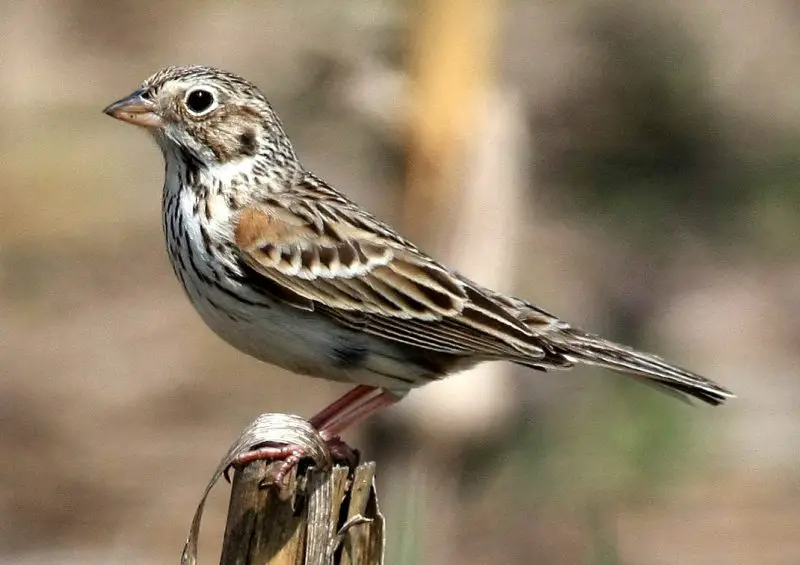
The Vesper Sparrow is a larger sparrow with streaked brown plumage, a white outer tail, and a subtle chestnut patch on the shoulder, visible when it takes flight. It measures around 5.9–6.3 inches (15–16 cm) in length and has a longer tail than many other sparrows. Its pleasant, flute-like song is often delivered in the evening, giving the species its name “vesper,” which means evening prayer.
In New Hampshire, Vesper Sparrows are summer breeders, found in open fields, pastures, and dry grassy meadows. They are more common in rural areas with less intensive agriculture, as they prefer undisturbed grasslands. By late fall, most migrate south to spend the winter.
These sparrows forage mainly on the ground, scratching for seeds and occasionally catching insects during the breeding season. They perch on fence posts or shrubs when singing, but otherwise remain close to the ground. Their nests are well-hidden in grass, making them vulnerable to mowing and grazing.
Fun Fact: Vesper Sparrows often sing later in the day than most sparrows, filling quiet summer evenings with their sweet song.
Saltmarsh Sparrow (Ammospiza caudacuta)
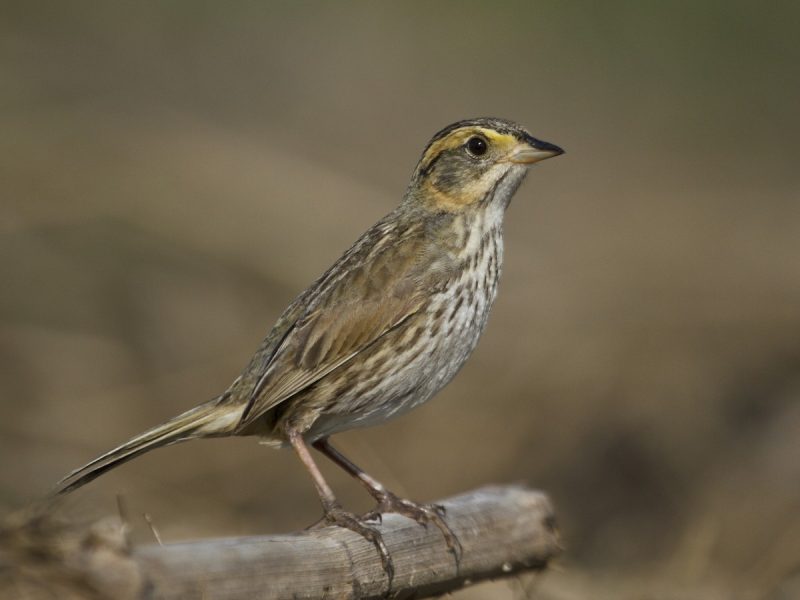
The Saltmarsh Sparrow is a secretive sparrow with streaky brown and buff plumage, a pale eyebrow stripe, and a faintly orange-tinged face. It measures about 4.7–5.1 inches (12–13 cm) long and has a slender build compared to some bulkier sparrows. Its muted colors blend perfectly into the grasses of coastal marshes.
In New Hampshire, this sparrow is rare and restricted to salt marshes along the coast during the breeding season or migration. Its population is declining due to rising sea levels and habitat loss, making it a conservation concern. Birders often need patience and a sharp eye to spot one.
Saltmarsh Sparrows are quiet and stay hidden in dense grasses, crawling through vegetation rather than flying. They feed on seeds and small insects, often foraging close to muddy ground. Nests are built low in marsh grasses, making them vulnerable to flooding during high tides.
Fun Fact: Saltmarsh Sparrows are one of the only songbirds in North America that build nests entirely in tidal marshes, making them highly specialized and vulnerable to climate change.
Eastern Towhee – Female (Pipilo erythrophthalmus)
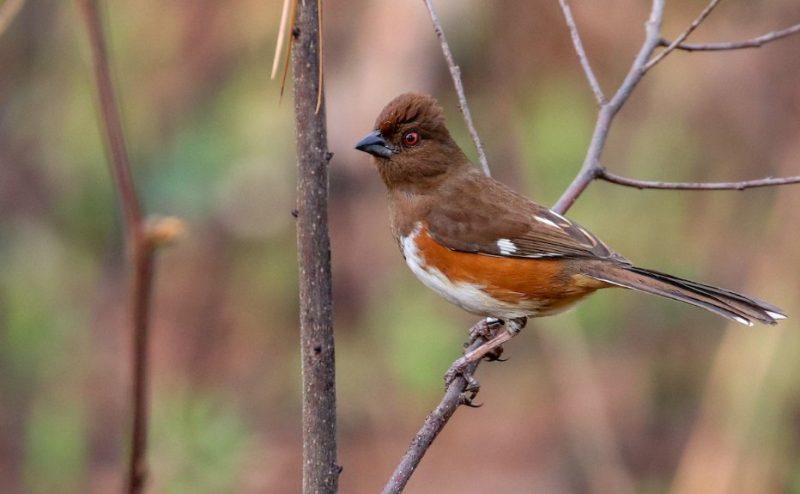
The female Eastern Towhee is a striking bird with warm brown upperparts, a white belly, and rufous flanks. It measures about 6.8–8.2 inches (17–21 cm), making it larger than most sparrows. Unlike the black-and-rufous males, females have a more muted brown coloration, helping them blend into leaf litter where they forage.
In New Hampshire, Eastern Towhees are summer breeders, favoring shrubby habitats, forest edges, and overgrown fields. They are more common in southern and central parts of the state. Towhees migrate south in winter, although some may remain in mild winters.
Behaviorally, they are energetic ground foragers, scratching at leaf litter with a distinctive “double-hop and kick” motion to uncover insects and seeds. They are often heard before they are seen, with a sharp “chewink” call echoing through the undergrowth. Males sing from exposed branches, while females stay hidden in dense brush.
Fun Fact: The Eastern Towhee’s distinctive foraging style is so recognizable that experienced birders can often identify them just by the sound of their scratching in dry leaves.
Fox Sparrow (Passerella iliaca)
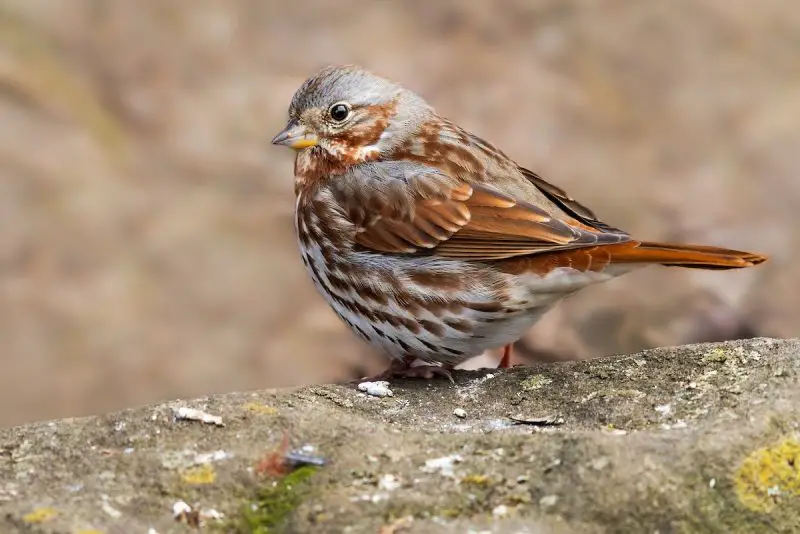
The Fox Sparrow is one of the largest sparrows found in New Hampshire, measuring around 6.3–7.5 inches (16–19 cm) in length. Its plumage is a rich reddish-brown, with heavy streaking on the breast and a bold, rounded body shape. The color resembles that of a red fox, which is how it earned its name. Its stout, conical bill is perfect for cracking seeds and digging through leaf litter.
In New Hampshire, Fox Sparrows are mostly seen during migration in spring and fall, though some may linger in winter, especially in southern regions. They prefer woodland edges, dense shrubs, and thickets, where they forage on the ground for seeds and insects. Their presence is often detected by their strong scratching behavior as they toss leaves aside in search of food.
Fox Sparrows are usually solitary or in small groups, and they are shy compared to other sparrows. However, they may visit backyard feeders in cold weather, especially if sunflower seeds or millet are available. Their song is rich, flute-like, and among the most musical of all sparrows.
Fun Fact: Fox Sparrows are known to scratch at the ground so vigorously that you can sometimes hear them before you see them, even from several yards away.
Lincoln’s Sparrow (Melospiza lincolnii)
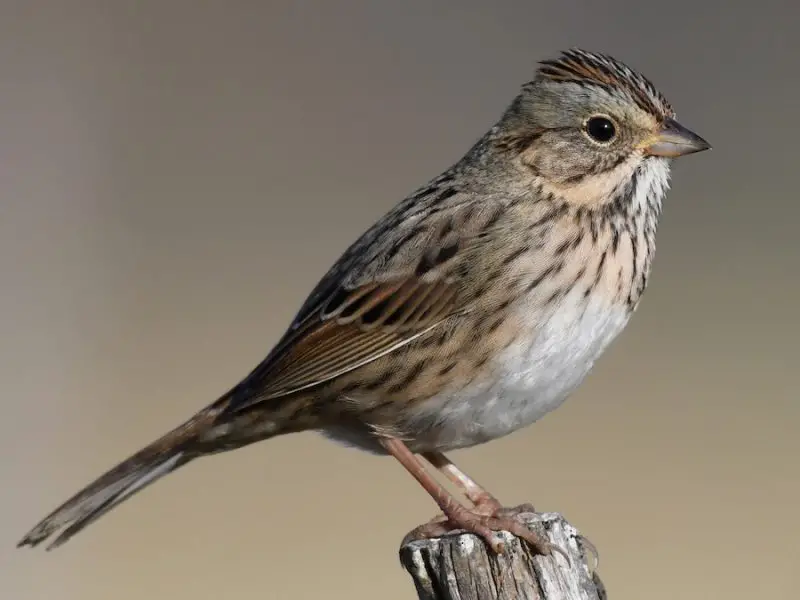
The Lincoln’s Sparrow is a beautifully patterned sparrow with fine streaks on its chest and a buffy wash across its breast. It is slightly smaller than a Song Sparrow, measuring about 5.1–5.9 inches (13–15 cm) in length. Its delicate facial markings, including a thin eye ring and subtle gray and brown tones, give it a refined appearance.
In New Hampshire, Lincoln’s Sparrows are primarily migrants, passing through during spring and fall. They prefer dense shrubs, wet meadows, and forest edges, where they remain well-hidden. Because of their secretive behavior, they are easily overlooked despite their presence during migration.
These sparrows forage low to the ground, eating seeds, insects, and small invertebrates. They are shy and rarely visit feeders, relying instead on natural foraging habitats. Their soft, tinkling song is one of the most beautiful among sparrows, though it is rarely heard in New Hampshire since they mostly sing on their breeding grounds farther north.
Fun Fact: Lincoln’s Sparrows were first described by John James Audubon, who named the bird after his friend Thomas Lincoln, who collected the first specimen.
White-crowned Sparrow (Zonotrichia leucophrys)
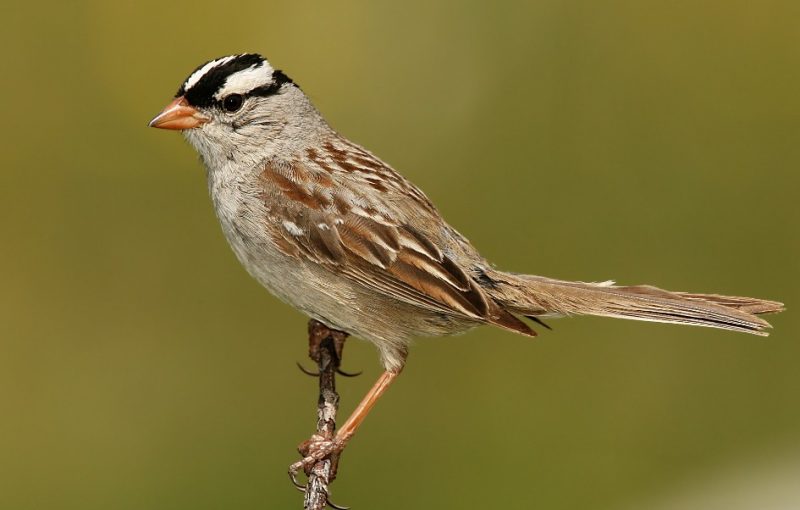
The White-crowned Sparrow is a striking sparrow with bold black-and-white stripes on its head, a gray face, and a plain brown body. Measuring about 5.9–6.3 inches (15–16 cm) in length, it is larger than many other sparrows. Its crisp head pattern makes it easy to identify, even from a distance.
In New Hampshire, White-crowned Sparrows are mostly seen during migration in spring and fall. They frequent open fields, weedy edges, and brushy habitats, sometimes visiting backyard feeders if millet or sunflower seeds are available. They rarely stay long, moving quickly to their northern breeding grounds.
These sparrows are ground foragers, scratching through leaf litter for seeds and insects. They are relatively tame during migration and sometimes feed in loose flocks with White-throated Sparrows and juncos. Their song is a series of clear whistles, often described as sounding like “poor Sam Peabody” in some regions.
Fun Fact: Young White-crowned Sparrows learn their songs from neighboring adults, and regional dialects develop just like with Song Sparrows.
Sedge Wren (Cistothorus platensis)
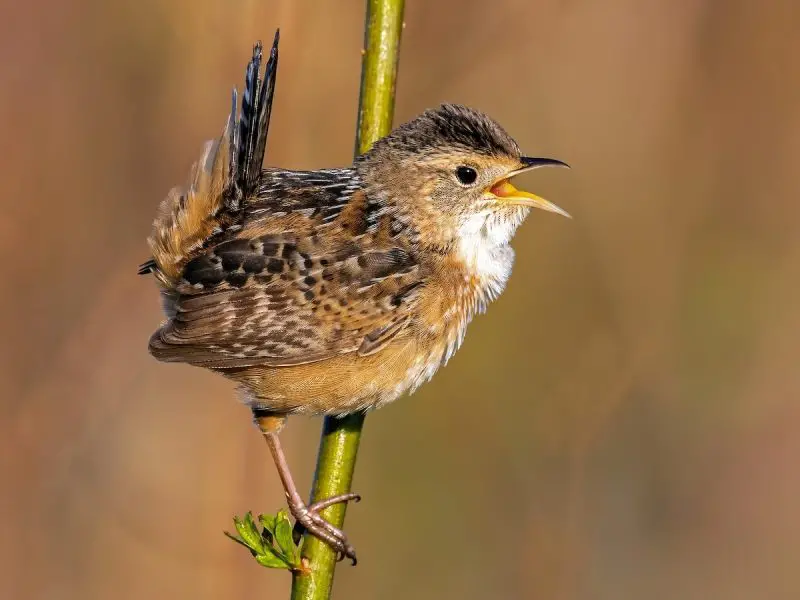
The Sedge Wren is a tiny, secretive wren measuring only 3.9–4.7 inches (10–12 cm) in length. Its plumage is brown with fine streaking on the back and a short, slightly barred tail. Its small size and streaky appearance help it disappear into tall grasses and sedges.
In New Hampshire, Sedge Wrens are rare and usually found only in suitable wetland habitats such as sedge meadows and marshy grasslands. They are more likely to be detected by sound than sight, as they deliver a rapid, chattering song while hidden in dense vegetation.
Behaviorally, Sedge Wrens are active but elusive, hopping low through grasses and occasionally perching briefly to sing. They feed on insects and small spiders, which they glean from vegetation. Unlike many wrens, they are irregular breeders in some areas, depending on habitat availability.
Fun Fact: Sedge Wrens often build multiple “dummy” nests in addition to the one they actually use, possibly as a strategy to confuse predators.
Marsh Wren (Cistothorus palustris)
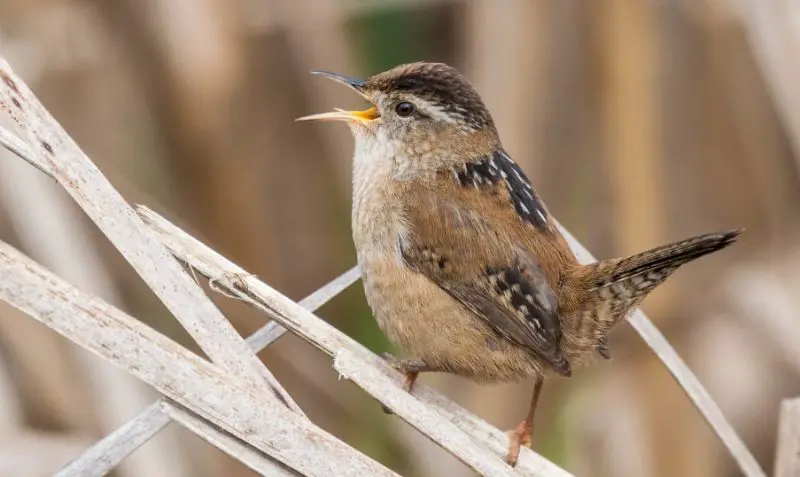
The Marsh Wren is a small, energetic bird with a brown back streaked with black and white, a bold white eyebrow, and a short, cocked tail. It measures about 3.9–5.1 inches (10–13 cm) long and has long legs adapted for moving through marsh vegetation. Its rapid, rattling song is loud and distinctive, often heard even when the bird is hidden.
In New Hampshire, Marsh Wrens are found in cattail marshes, wet meadows, and swampy areas during the breeding season. They weave intricate dome-shaped nests attached to reeds or grasses, often above shallow water. Their populations are more common along the coast and large inland wetlands.
Marsh Wrens are active and territorial, frequently scolding intruders and chasing other birds from their territory. They forage by creeping through reeds, searching for insects, spiders, and other small invertebrates. Despite their small size, they are aggressive toward other marsh-dwelling birds.
Fun Fact: Male Marsh Wrens build multiple unused nests within their territory, which they display to females as part of their courtship behavior.
House Wren (Troglodytes aedon)
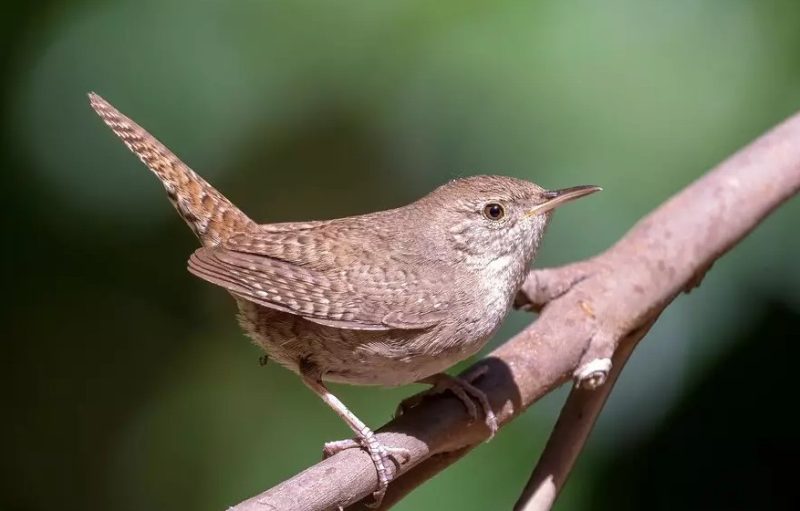
The House Wren is a small, energetic bird measuring about 4.3–5.1 inches (11–13 cm) in length, with warm brown plumage and faint barring on its wings and tail. It has a slightly curved bill and a short tail often held upright. Its cheerful, bubbly song is common throughout New Hampshire during the breeding season.
House Wrens favor open woodlands, gardens, and suburban areas with plenty of shrubs and brushy spots for nesting. They readily use nest boxes and cavities, often filling them with sticks to the point of overcrowding. They are highly territorial and will vigorously defend their nesting area from other birds.
Behaviorally, House Wrens are active foragers, flitting through dense vegetation in search of insects and spiders. They rarely perch openly but instead move quickly through branches and underbrush. Their nests are constructed from twigs, grass, and feathers, usually in cavities or nest boxes.
Fun Fact: House Wrens are known for sometimes destroying the eggs or nestlings of other birds to reduce competition for nesting sites.
Winter Wren (Troglodytes hiemalis)

The Winter Wren is one of the smallest birds in New Hampshire, measuring about 3.5–4.5 inches (9–12 cm) long. It has dark brown plumage with subtle barring and a short tail often held erect. Its loud, complex song carries far across forested areas during the breeding season, despite its tiny size.
In New Hampshire, Winter Wrens inhabit dense coniferous and mixed forests, often near streams or moist areas. They are shy and elusive, spending much time hidden in thick underbrush, moss, and fallen logs. Their nests are carefully concealed in tree cavities or rock crevices.
Winter Wrens forage actively on the forest floor and low vegetation, gleaning insects, spiders, and larvae. They are well-adapted to cold weather and remain in New Hampshire year-round, often calling even in winter.
Fun Fact: Despite their small size, Winter Wrens produce one of the loudest and most complex songs relative to their body size among North American birds.
Carolina Wren (Thryothorus ludovicianus)
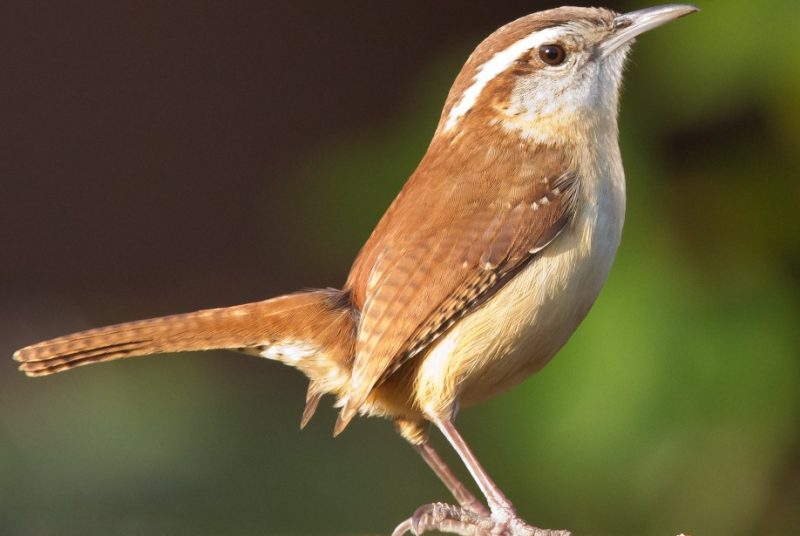
The Carolina Wren is a vibrant and vocal bird about 5.5–6.3 inches (14–16 cm) long, with bright reddish-brown plumage and a bold white stripe above the eye. It is more common in the southern United States but has been expanding its range northward into parts of New Hampshire, especially during mild winters.
Carolina Wrens prefer dense thickets, wooded suburbs, and brushy areas. They are year-round residents where they occur and are known for their loud, melodious song, often described as “teakettle-teakettle-teakettle.” They are highly adaptable and will nest in a variety of locations, including birdhouses, mailboxes, and even unusual human structures.
These wrens forage close to the ground, searching for insects, spiders, and other invertebrates. They are curious and bold, sometimes approaching humans more closely than other wrens.
Fun Fact: Carolina Wrens can produce multiple broods in a single year, sometimes up to four, which helps their populations expand rapidly.
Bewick’s Wren (Thryomanes bewickii)
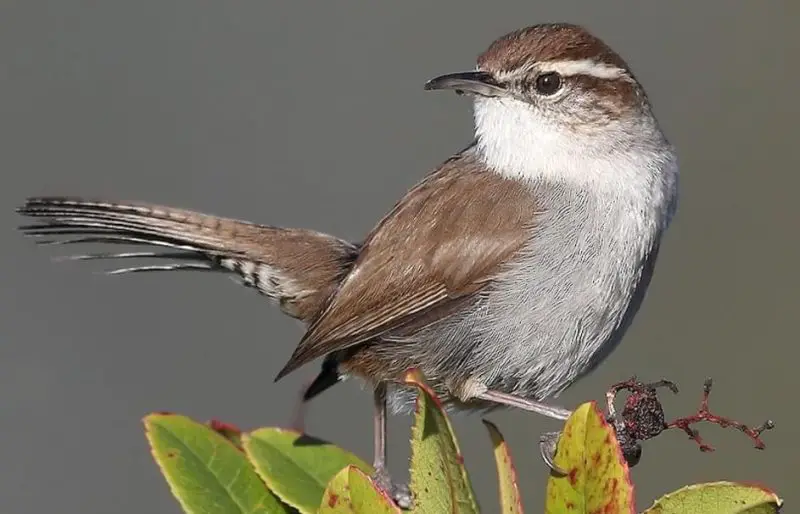
Bewick’s Wren is a medium-sized wren about 6–7 inches (15–18 cm) long, with brown upperparts and a long tail often held upright. It has a distinctive white eyebrow stripe and finely barred wings and tail. This species is uncommon in New Hampshire and mostly seen during migration or rare winter visits.
In its preferred habitat of brushy fields, open woodlands, and shrublands, Bewick’s Wren is an active forager, gleaning insects from leaves and branches. It often sings a loud, musical, and varied song from exposed perches. Due to its rarity in New Hampshire, sightings are prized by birdwatchers.
Bewick’s Wrens build cup-shaped nests in cavities, crevices, or man-made structures. They are territorial during breeding and will vigorously defend their nests from intruders.
Fun Fact: Bewick’s Wrens are named after the English engraver Thomas Bewick, who illustrated many British birds in the 18th century.
Gray Catbird (Dumetella carolinensis)
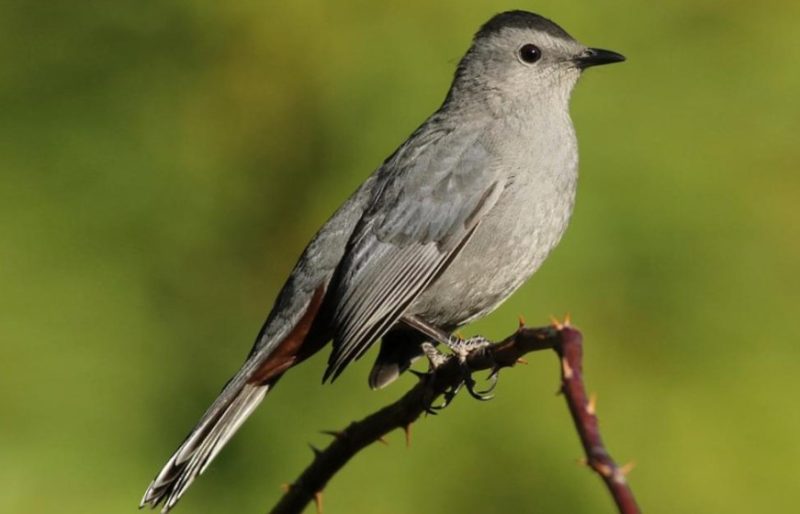
The Gray Catbird is a medium-sized songbird about 8–9 inches (20–23 cm) long, with slate-gray plumage, a black cap, and rusty undertail coverts. It is named for its distinctive cat-like “mewing” call. Gray Catbirds are common breeders in New Hampshire, often found in dense thickets, shrubby edges, and gardens.
These birds are secretive but vocal, known for their ability to mimic the songs and calls of other birds and even mechanical sounds. Their varied song is a rich mix of whistles, clicks, and imitations, often delivered from concealed perches.
Gray Catbirds forage for insects, berries, and small fruits, usually close to the ground or in dense foliage. They build bulky nests in shrubs or low trees and are fiercely protective of their territory during breeding season.
Fun Fact: Gray Catbirds have a habit of wiping their prey on branches or leaves before eating, similar to how cats clean their paws.
FAQs about Small Brown Birds in New Hampshire
What are some common small brown birds found in New Hampshire?
Common small brown birds in New Hampshire include species like the Song Sparrow, Swamp Sparrow, American Tree Sparrow, House Sparrow, Dark-eyed Junco, White-throated Sparrow, Chipping Sparrow, Savannah Sparrow, and Field Sparrow.
How can I identify small brown birds that look very similar?
Identification often relies on subtle features such as streak patterns, size, bill shape, habitat, and behavior. Listening to their songs or calls can also help, as many sparrows and wrens have distinctive vocalizations.
When is the best time to see small brown birds in New Hampshire?
Many small brown birds are present year-round, but some species, like the American Tree Sparrow and Dark-eyed Junco, are mainly winter visitors. Spring and fall migrations also bring additional sparrows and wrens through the state.
Do small brown birds visit backyard feeders?
Yes, several species such as Song Sparrows, Dark-eyed Juncos, and House Sparrows frequently visit backyard feeders, especially if seeds like millet, sunflower, or cracked corn are provided.
What habitats do small brown birds prefer in New Hampshire?
Small brown birds inhabit a range of environments including woodlands, wetlands, grassy fields, shrublands, marshes, and urban areas. Each species has its preferred habitat, such as Swamp Sparrows favoring wetlands and Savannah Sparrows preferring open grassy fields.
Are any small brown birds in New Hampshire endangered or declining?
Some species like the Grasshopper Sparrow and Saltmarsh Sparrow are experiencing population declines due to habitat loss and environmental changes. Conservation efforts focus on protecting and restoring their preferred habitats.
How can I attract small brown birds to my yard?
Providing a mix of native plants, shrubs for cover, and bird feeders stocked with appropriate seeds can attract many small brown birds. Avoiding pesticides helps ensure a supply of insects, an important food source for many species during breeding.

